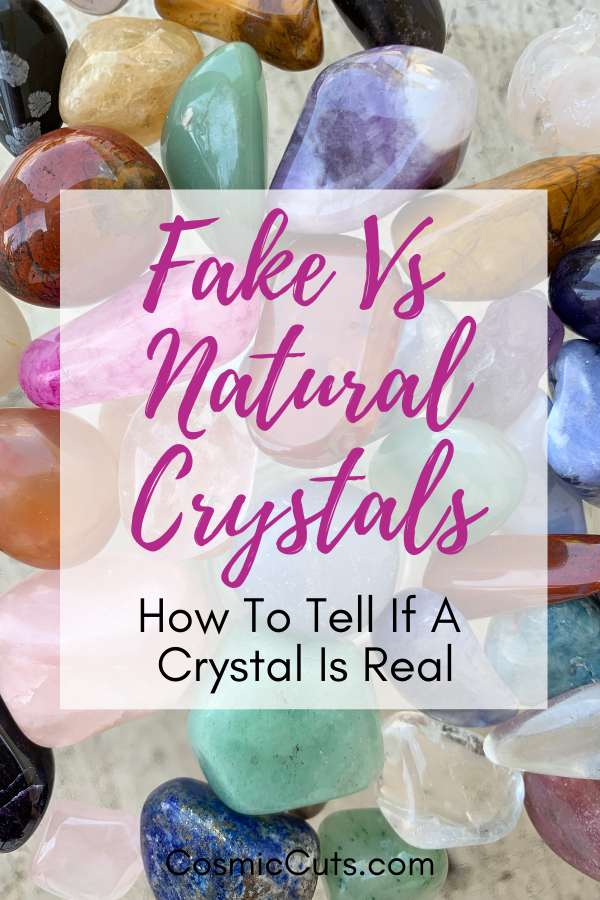Fake vs Natural Crystals: How to Tell if a Crystal is Real
INSIDE: When you know how to spot natural crystals verses fake ones, you can feel more confident in the purchases you make. Use these tips to help you learn how to tell if a crystal is real or not.
Because crystal therapy is rapidly gaining in popularity, we are seeing more and more synthetic crystals on the market. For people who are new to collecting gemstones, this can be a real challenge.
It's disheartening when we end up not only spending money on a fake, but also not getting the crystal we wanted.
Science Magazine has posted interesting research results, showing that synthetic Quartz not only does not have the same properties but is much more prone to developing anomalies and breaking.
So, what is the distinction between a fake and a real gemstone? What is the research guarantee that the crystal we bought is a real one?
Well, if you're wondering how you can determine whether a certain crystal is the real deal, without extravagant science experiments at your disposal, you're in the right place.
Here's everything you need to know about fake vs. natural crystals...
Characteristics Of Natural Gemstones
Natural gemstones are products of nature. They are the results of years and centuries of formation, and interactions with the earth, minerals, water, air, light, and darkness.
In other words, they can’t be formed overnight.
Crystal structure takes a long, long time to form, which is what makes natural gemstones so precious.
Natural crystals hold energy and are high-vibrational, which can be immediately felt when holding one. As they are exposed to all of the shifts that occur in nature, they form a specific structure and resilience, also absorbing very unique energies.
As a result, they have an extremely unique ‘’energy DNA,’’ as well as incredible healing powers.
While synthetic crystal makers can imitate the magic ingredients a natural gemstone is made of, what they can’t do is imitate nature and energy.
This means that yes when buying a synthetic crystal, you might have the minerals and chemicals in place, but without the quality and the healing properties.
Natural crystals are stronger and have characteristic growth structures and markings that show their history.
Generally speaking, when learning how to tell if a crystal is real, you can look to the Moh’s hardness scale. Real crystals score higher on the scale, which means they are much more resilient to damage and scratches.
How to Tell if a Crystal is Fake?
Synthetic gemstones can be lab-grown, created by something called flux-growth, or through the melting process.
None of those procedures creates healing properties. It is so common to see fake pieces that are colored and modified plastic or glass.
Aside from the price and look of crystals, some other things can help you figure out whether they are real or not.
There are a few tests and measures of precaution that you can do to be certain that what you're purchasing is a gift from nature, and not just another low-quality man-made product.
Always Shop From a Reputable Seller
This is the safest way to ensure that the crystals you order are indeed what are promised. Reputable sellers are verified by numerous buyers, plenty of which have a lot of experience with crystals.
Do look for positive feedback and reviews - the more, the better. Shopping from a reputable seller is the best measure of precaution you can take, as until the crystal arrives, all you have is a pretty picture.
You can read about the grading system that we use for our geodes and crystals here.
Trust the Name
A crystal that has an overly exotic name such as Strawberry Quartz, Blue Moonstone, Arizona Spinel, or Smoky Topaz is more likely than not, a fake. These are almost always chemically treated, made in the lab, modified, or made of plastic.
But, it can be hard to tell since there are plenty of similar-sounding crystal names that are natural, such as Smoky Quartz, Blue Apatite, and Snowflake Obsidian.
The best way to stay away from fake names is to inform yourself on the names of natural crystals.
Test the Hardness Yourself
Natural crystals and stones are far less fragile than synthetic ones.
For instance, on a scale of mineral hardness that goes from 1 to 10, natural Quartz is a 7. This means that any formation that scored lower than that won’t be able to scratch or damage it.
- Find your crystal on the Moh's scale here.
- Scratch your crystal with a mineral that is lower than it on the scale.
- If it gets damaged, you’ve received something that was made in a lab.
WARNING: Make sure the crystal you are scratching isn't a softer natural crystal. Each crystal on the Moh's scale can be scratched by itself or any crystals above it. No crystals can be scratched by any below it on the scale.
If your crystal has sharp edges, you might also choose to test the hardness by using it to scratch glass or plastic. Most real crystals will leave a scratch mark on those materials.
Test the Weight
Natural gemstones are heavier than fakes. Crystals are heavier than glass. So, if you are inexperienced, the easiest way to examine whether you have a real crystal or not is to test the weight next to glass pieces of a similar size.
If the crystal you're holding or measuring on a scale is lighter or the same weight, there is a very high likelihood that you've acquired a fake.
True gemstones contain more led than synthetic formations, and thus will be denser and heavier.
Test the Color
Before we jump into the color test, it's important to say that some real crystals are truly intense in color, such as Black Tourmaline or Red Jasper.
However, there are some crystals that can gain a more intense color through heat treatment. The heating process is used to make permanent changes to the appearance of the stone, both regarding the clarity and the color.
The most commonly heat-treated stones are Citrine, Amethyst, and Aquamarine, which gain a recognizable darker color after the treatment.
NOTE: Heat-treated crystals aren't necessarily considered fake, and they do contain healing properties since they are real crystals.
Dyed ones are different, however. Dyed and chemically treated crystals are recognized by very intense, unnatural colors.
For instance, intensely pink Rose Quartz is likely a fake. The best way to test the color is to rely on online sources.
Comparing images of crystals you find on reputable websites can help you figure out whether what you are holding is real or not.
Common Examples Of Fake Crystals To Look Out For
There are a few crystals that are both commonly sought after and frequently plagiarized. They are frequently sold at low prices and widely available online.
Here's what to specifically look out for...
Fake Clear Quartz, Rose Quartz & Smokey Quartz
The most commonly faked crystals are those that belong to the Quartz family. This is because they seem to be easy to imitate to visually resemble real gemstones.
There are plenty of lab-made and colored glass pieces that are being sold as Clear Quartz, Smoky Quartz, Rose Quartz, or Amethyst.
Natural Quartz crystals are heavier than and can’t be scratched or damaged by glass. Additionally, real Quartz crystals are cool to the touch and won’t have bubbles when looked at under a magnifying glass.
Fake Citrine
Citrine can be and is frequently heat-treated. However, what some sellers do is heat-treat Amethyst pieces to turn it into Citrine. The results are astonishingly similar, and in both cases, the two will be very much alike.
Both are Quartz crystals, however, Natural Citrine will have much more transparency to it. Its color won't vary much and will be in the range between pale yellow to natural honey shades.
Unlike natural crystals, fake Citrine will be intensely yellow and orange, with more distinct shade variations, far less transparency, and an intensely white base.
Final Thoughts
With these tips, you can feel a little more confident in knowing whether your purchases are natural crystals are fake. In the end, as long as you purchase from a reputable crystal dealer, like Cosmic Cuts, you can rest assured you're getting what you paid for.
* Crystals and stones should not be used as a substitute for medical advice or treatment. Please read our full disclaimer notice here.








Hi LuLu, we can recommend ourselves! Browse our incredible selection of authentic one-of-a-kind crystals at https://cosmiccuts.com. Happy shopping!
I am new at crystals and starting to get into it. I read the above information. Can you recommend a seller that sells real crystals?
Thank you. Very informative read. Blessings to you.
Leave a comment